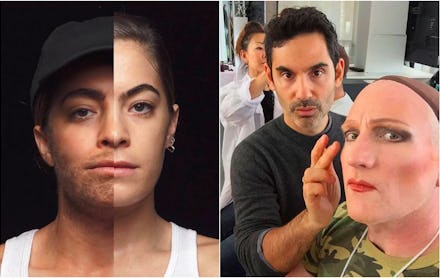These Makeup Transformations Will Help You Rethink How You View Gender

I knew what I was getting myself into but that didn't make the results any less startling. As I looked into the mirror, an alternate version of me stared back: one that was markedly free of my usual combination of lipstick, blush and mascara.
In its place, I had under-eye circles and a strong jawline that had been painted on. My eyebrows were drawn into an unruly mess and I had a scruffy five-o-clock shadow splashed across my face. Tiny hairs stuck to my skin, helping create the illusion of a beard that was a few days old.
With the help of a few good makeup tricks, I'd just undergone my "crossover" transformation from woman to man.
I went from looking like this...
to looking like this:
I wasn't the only one who'd swapped genders with the help of makeup.
Art and fashion for everyone: My makeover was part of an installation called "Crossover" held at Brookfield Place, a shopping center in New York City. "Crossover" was one of a handful of activities called "movements," created for Move!, an art and fashion event curated by Cecilia Dean, founder of the publication Visionaire, and David Colman, a contributing writer to the New York Times. Dean and Colman partnered a handful of designers with contemporary artists to create different activities for Move!, which visitors to Brookfield Place could participate in.
Move! first occurred in 2010 at MoMA PS1 in New York City, then in 2013 in Sao Paulo, Brazil, as a way to make fashion and art more relatable to the masses, Dean told Whitewall magazine. On the surface, the events seem like ordinary activities, like, say getting a makeover or trying on a dress. The reality, though, is they're performance art pieces, called "movements," the public participates in almost without knowing, Dean told Whitewall.
The concept of Move! first came about as a way to provide activities that bridge the gap between the sometimes-exclusive atmosphere surrounding art and fashion circles, Dean told Whitewall. Among the options for the performance art pieces were events like "Pose," where visitors could slip on one of Diane von Furstenberg's iconic wrap dresses and have a textile pattern and dress created based on their photographed image. Visitors could also stop by "Fifteen Minutes" for an interview with painter Liz Markus, who would paint silk scarves based on a participant's memory. Visitors wouldn't just be staring at art and fashion, they would be interacting with it.
My gender transformation was part of "Crossover," one of the so-called "movements" available to the public. The installation was the brainchild of makeup artist James Kaliardos, who'd created it in partnership with Cos Bar. Along with the help of his team of makeup artists, visitors had the "unique opportunity to have have [their] gender flawlessly transformed," according to the event website. "We wanted to offer participants the opportunity to see themselves differently than who they are every day. We figured the most powerful change would be to cross over to the opposite sex," Kaliardos told Refinery29.
Kaliardos previewed the event with a time-lapse video where he worked his makeup magic on Chelsea Leyland, a DJ with sandy blonde hair. Using a deep-colored foundation, he creates shadows on Leyland and uses a static balloon to evenly apply hair to the face.
The before-and-after looks offered striking examples of the powerful and transformative effects of makeup.
"Crossing" genders in a time of gender fluidity: "Crossover" might have just been an entertaining way for curious visitors to see themselves in a different light but the timing coincides with an ongoing discussion about gender conventions in fashion and the culture at-large. Designers have been continuously pushing the boundaries of what is socially deemed as being for men or for women. They've done this by releasing gender-neutral clothing, with men wearing skirts, dresses and the occasional heels. They've cast androgynous models on the runway and sometimes discreetly included models in clothing collections for the opposite sex.
The line between what is deemed strictly male and female keeps blurring and is helped by the rising visibility of gender-fluid models and artists who explore how individuals can simultaneously possess feminine and masculine elements. It's a concept photographer Gabrielle Revere explored in an intimate photo series with Seth Atwell, a rising gender-fluid model.
"I wanted to play a bit with this idea of what defines a man and what defines a woman. Seth is exceptionally beautiful and there were times when I was spending time with Seth and looking through the camera, and there was masculinity present," Revere told Refinery29. "And then, certain profile changes would be made, and suddenly, there was some incredible femininity."
I saw some of this fluidity in my own makeup transformation from a woman to a man. I'm a feminine person by nature, I think, and relish a made-up face full of color.
But, seeing myself with masculine features was eye-opening. Looking in the mirror, I tilted my head with attitude, scrunched my eyebrows and was weary of smiling, feeling as if that was somehow more "manly."
"See? This is the reaction we get," Kessia Randolph, my makeup artist, told me. "It's just strange to see yourself as something but yourself."